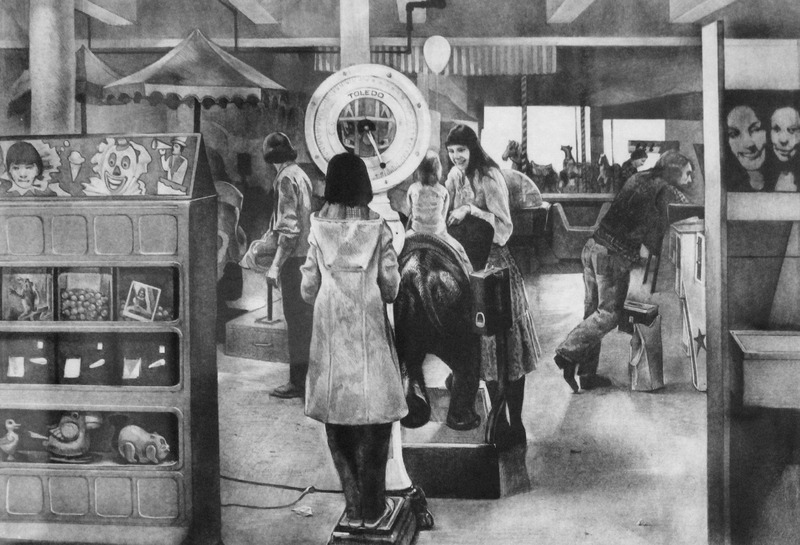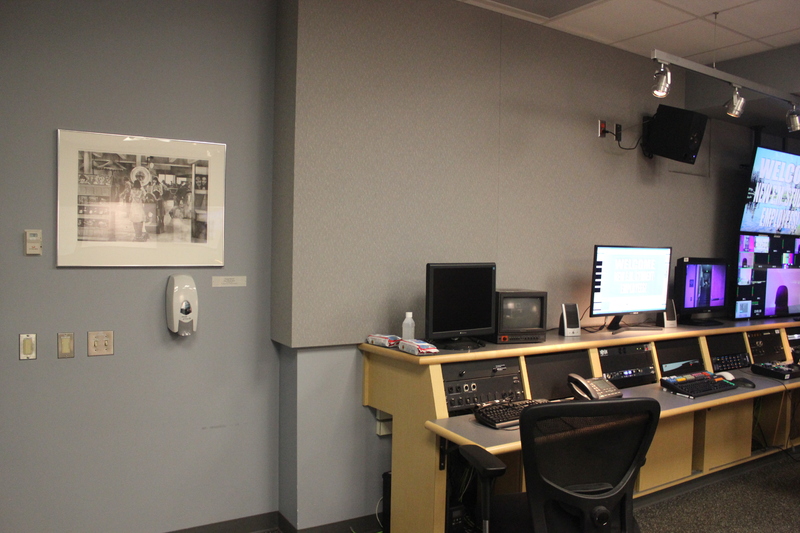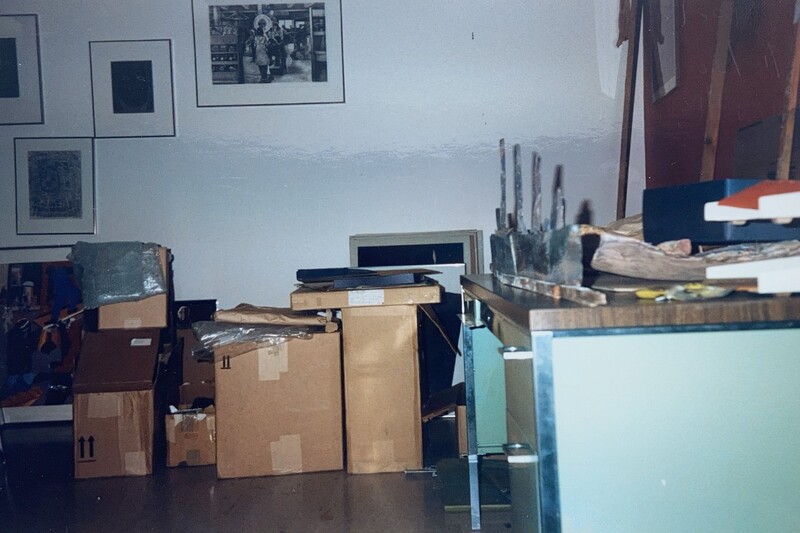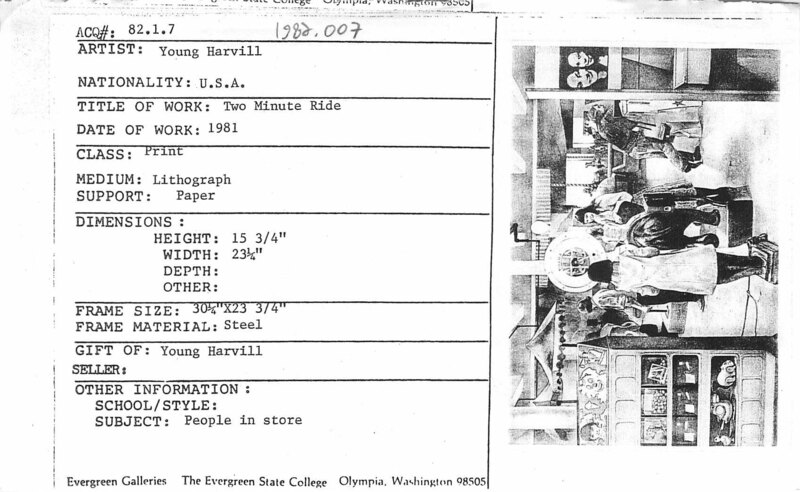-
Title
-
Two Minute Ride
-
Creator
-
Young Harvill
-
Artist ID
-
92
-
Date of Work
-
1981
-
Description
-
Black and white image at a carnival. Person on a scale, child on horse ride, and carousel in the background.
-
Category of Media
-
Print
-
Media
-
Lithograph
-
Accession Number
-
1982.007
-
Location
-
Display: Library Building, 1st Floor, CCAM - 1352
-
Date Acquired
-
5251982
-
Acquisition Method
-
donation, unrestricted
-
Dimensions of Work
-
15.75" x 23.25"
-
Frame Dimensions
-
30.25" x 23.75"
-
Frame Type
-
Steel
-
Donor or Seller
-
Harvill
-
Donor ID
-
92
-
Artist Bio
-
Young Harvill, ’76, has a long list of high-tech accomplishments to his name. He has participated in the births of several influential Bay Area technology firms, including one of San Francisco’s first multimedia companies—Paracomp, which was later acquired by Macromedia—and he was a principal investigator on several patents. His titles have included research fellow, senior engineer, chief scientist, chief technology officer, vice president of engineering, and vice president of research and development.
Harvill is a virtual reality (VR) pioneer. He co-created the DataGlove, an early VR device, and invented Swivel 3D, one of the first modelers for desktop computers in which a three-dimensional model is generated from a flat image. He designed Macromodel, a 3-D multimedia modeler, and the Pulse Creator, a Web authoring tool that allows a user to add life and personality to computer-generated images by combining 3-D modeling with interactive, realistic character animation. Plus, he co-developed the Director Player – the precursor of the Shockwave multimedia player.
So it comes as a surprise to discover that Evergreen’s library lays claim to a limited edition book Harvill made in 1978, while he was an adjunct faculty member teaching fine arts at the college and working in the printmaking studio. Entitled Las Momias de Guanajuato: A Suite of Five Photo-Gravures Photographed, Designed, & Printed by Young Harvill, the book holds prints handmade by using the process of photogravure—the name of which is derived from the French words for “light” and “engraving.”
Harvill, it turns out, is one of those rare souls who are able to nimbly navigate across the sometimes-wobbly bridge between science and art. And he is frequently focused on using light to convey three-dimensional space, and thus to create models that approximate life itself.
"What’s amazing about Evergreen is that it manages to have structure and essentially a will to teach that is very definite and very strong and yet not composed of artificial boundaries between things..."
Harvill’s interest in the fusion of visual arts and technology was formed early on. He learned to count and do arithmetic in binary code from his father, a one-time field engineer and computer operator for the company that made UNIVAC, the world’s first commercial computer. He listened to his dad and his brother work out algorithms for solving problems, and often had opportunities to play on a computer, writing simple programs in Fortran. But his interest in the machine was only really piqued when it gained a rudimentary capability for generating graphics, which happened with the development of PLATO, an early computer-assisted instruction system that allowed users to plot lines of light.
His fascination with light in space prompted him to later study holography—a form of photography that uses laser light to record an image in three dimensions—first with Lee Anderson, an electronics whiz at Evergreen, then at Stanford University, where he earned a master of fine arts in 1984. He was later granted a fellowship from Stanford to further his work in printmaking and computer-controlled holography.
After graduating from Stanford, Harvill worked for a year with the Anderson Collection, one of the world’s largest and finest private collections of 20th century American art. At the time, he was a student spouse; his wife Ann Lasko-Harvill, whom he married in Olympia in 1977, was studying product design engineering at Stanford. In his spare time, Harvill wrote the program for Swivel 3D, a software program for creating computer art, which gave users the ability to build interesting worlds on a Macintosh computer. He licensed the program to VPL Research, the first company to sell VR products.
In 1985 Harvill joined VPL, becoming the company’s fourth employee. He worked on RB2 (“Reality Built for Two”), the first VR system, and co-invented the DataGlove, one of the world’s first commercial VR products, which graced the October 1987 cover of Scientific American. Wired to a computer, the interactive DataGlove used fiber-optic bundles to discern hand movements and transmit the information to a computer, where the movements could be duplicated. The device made it possible to translate the wearer’s gestures into manipulations of virtual objects, which has had applications in fields from gaming to remote-control surgery.
From there, Harvill went on to co-found Paracomp in San Francisco, and continued a long line of notable tech innovations (see Evergreen magazine article for details). At around the same time, Harvill endowed Evergreen with the Tom Rye Harvill Award to honor his father, who died in 1997. Open to faculty, staff, and alumni, the $5,000 award makes it possible for the recipients “to explore the intersections of art and science through the visual arts, literature, multimedia, dance, theater and any other compelling media including those emerging from the hard sciences.” He created the award because of his belief that “one of the surest ways to generate a sense of happiness is to give things away.”
Harvill believes Evergreen made it possible for him to merge his interest in technology and the arts, the latter of which he said is oftentimes considered a “poor cousin to technology.”
With his deep knowledge of both computers and art, this inventor of some of the key components of VR and modern computer technology continues to be interested in printmaking, using a mix of old and new media to transmit information.
Source: https://www.evergreen.edu/magazine/2008spring/harvill







